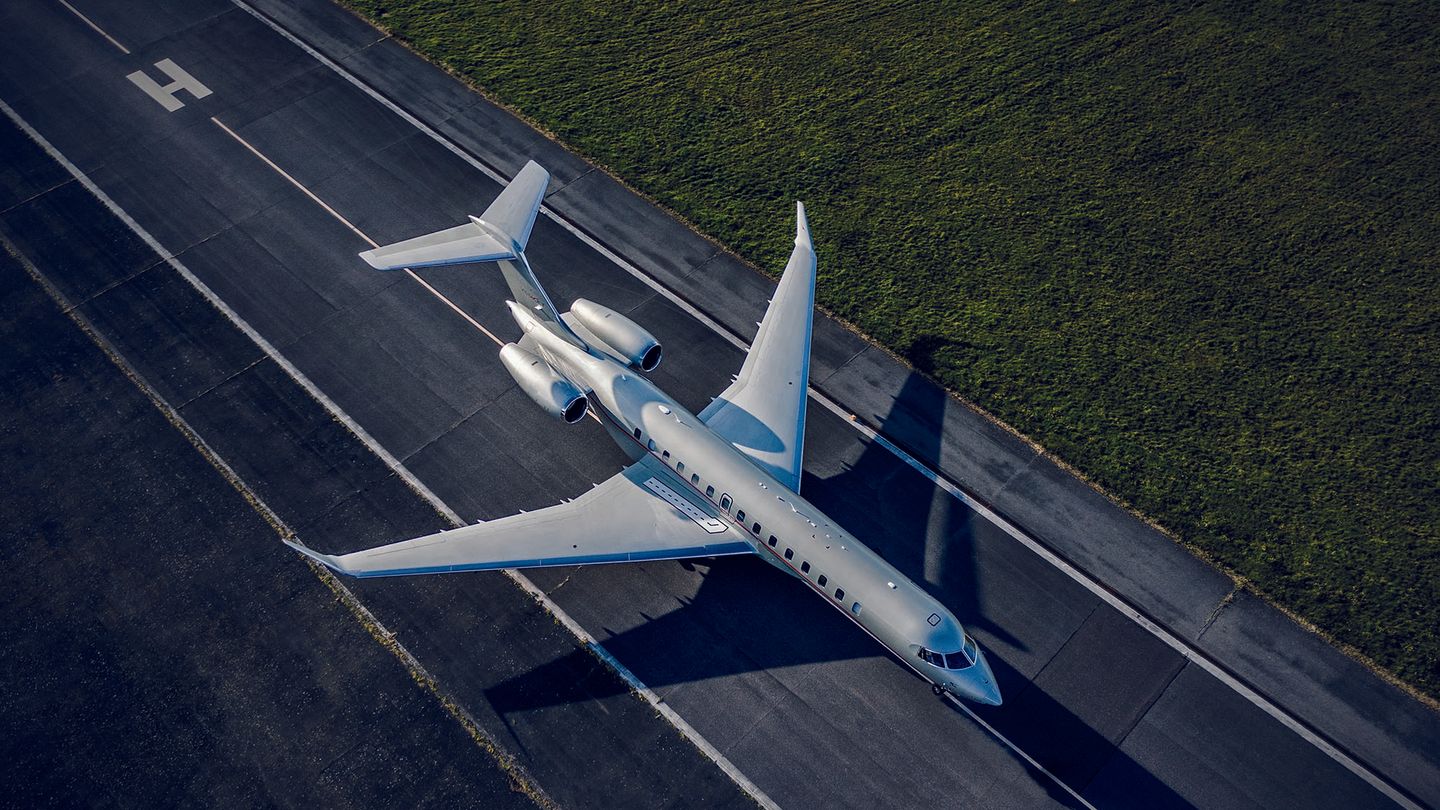

How Much Does a Private Jet Cost To Buy
Asking how much a private jet costs is rather like inquiring about the price of time. The answer depends on how finely one wishes to measure convenience and how quietly one expects it delivered.
- Words: Rupert Taylor
There are many ways to lose money beautifully. Buying a private jet is the most aerodynamic.
It begins with a whisper of curiosity. A late-night search. A rumour overheard at the bar of a Mayfair hotel. Someone you know “looked into getting one,” as if it were a Labrador. Then the fatal question escapes: How much does a private jet cost? At which point every seasoned owner smiles the same knowing smile, the one that says,
“If you have to ask, you can probably afford the fuel but not the fun.”
Yet curiosity is a civic virtue, and aviation a seductive vice. So, for the sake of good manners and bad financial planning, let us examine the numbers, the rituals, and the quiet comedy of the private jet ownership cost, and what it really means to own a piece of sky.
The Entry-Level Illusion
The lowest rung of private aviation is known, rather hopefully, as the “entry-level” jet. These machines promise the freedom of flight without the faint shame of economy boarding. They are compact, efficient, and aimed squarely at the ambitious professional who suspects the world is conspiring to waste his time and wonders how rich you have to be to own a private jet. It is here that the true private jet cost breakdown begins.
Take the Cirrus Vision Jet SF50, a single-engine contraption that costs between $2.2m and $4.1m, depending on whether you like your aircraft gently used or still smelling of factory varnish. It carries five passengers, performs beautifully, and costs about $670 per hour to operate. Which, in private aviation terms, is the equivalent of eating salad for lunch.
Then there is the Eclipse 500/550, retailing between $1m and $2.2m. Charming, nimble, and occasionally available in colours best described as “executive optimism.” Its great virtue is thrift. Its great flaw is that finding spare parts can feel like sourcing truffles in winter.
The HondaJet HA-420, meanwhile, is a favourite among those who describe themselves as practical. IIt ranges from $2.5m to $5m, which is to say, roughly the price of the average London parking space per passenger seat. Maintenance costs and pilot training, however, have a way of reminding their owners that even thrift requires resources.
The Cessna Citation Mustang costs between one point seven and two point six million, while the Embraer Phenom 100EV stretches to about five million. Both are reliable, capable, and adored by those who claim to value “flexibility.” In truth, they value being able to say, quite casually, “We’ll take the jet.”
These smaller aircraft are often flown by their owners, who like to believe they are “hands-on” rather than merely unwilling to hire a pilot. It is an attractive illusion. There is something marvellously romantic about the idea of guiding one’s own machine above the clouds, until, of course, one discovers the price of insurance.
The Mid-Air Middle Class of Private Jets
Beyond the fledgling flyers lies the broad, comfortable waistline of private aviation. These are the light and midsize jets that carry eight to ten passengers in the style of a well-run boutique hotel, and they introduce the subtler private jet cost factors that separate mere convenience from genuine comfort.
Here we find the Citation Latitude, the Embraer Praetor, and a variety of mid-range Phenoms, each offering the promise of continental travel without the indignity of customs queues. Prices stretch from $5m to $30m, depending on how shiny one's ego feels that year.
These are the workhorses of the elite, the machines of chief executives, discreet entrepreneurs, and politicians who prefer their scandals airborne. They can cross oceans, outrun weather, and project an aura of competence that occasionally extends to their owners.
Operating one is rather like running a small hotel that moves. Maintenance can consume hundreds of thousands annually, insurance adds $30,000 to $75,000, and fuel is charged not by the gallon but by the sigh. Hangar space at desirable airports costs as much as a London flat, and unlike a flat, it cannot be sublet when you tire of it.
Yet for all the absurdity, these jets possess a certain dignity. The cabins are lined in leather that has clearly been money. The wood panelling glows. Even the lavatories are fitted with fixtures that make one briefly believe in civilisation.
The Stratospheric Statement Piece in Luxury Private Jets
At the summit of aviation’s social ladder float the true palaces of the sky: the Gulfstream G650, the G700, and the Bombardier Global 8000.
The Gulfstream G700 retails for about $75m to $80m, which sounds ridiculous until one learns that the Bombardier Global 8000 costs $78m. For this, you receive a machine that can fly from London to Sydney without pause, a feature most relationships lack.
The G700’s cabin is larger than most apartments in Kensington, its air filtration better than most hospitals, and its lighting clever enough to flatter anyone who can still be flattered. The Wi-Fi is faster than reason. The wine fridge is pressurised to preserve both bottles and reputations.
Owning the most expensive private jet is not about need; it is about narrative. The aircraft itself becomes a travelling anecdote, a way of saying to the world, “I have arrived, and I intend to keep arriving until morale improves.”
The Annual Cost of Owning a Private Jet
Every paradise has a maintenance department. Even modest jets require deferred maintenance of between £100,000 and £500,000. Insurance for smaller models sits between $30,000 and $75,000 a year; for the leviathans, nearer $500,000. Hangar fees can range from $30,000 to $200,000, depending on location and ambition, and these numbers form the heart of the private jet cost per year that owners tend to mention only after a long drink.
Fuel bills are best discussed in the abstract. Light jets consume about $80 to $180 per hour. Larger aircraft transform money directly into vapour at several thousand dollars an hour.
Then there is the staff. Pilots expect six-figure salaries, and flight attendants, engineers, and mechanics do not work for gratitude alone. Every flight, therefore, resembles a modest theatrical production in which you are the sole audience member.
Depreciation remains the quiet assassin of all ambition. Light jets lose between thirty-five and fifty percent of their value within five years. Larger ones fare slightly better, which is to say they sink more gracefully. And still, owners speak of these costs with fond detachment, as though describing an eccentric uncle who drinks but means well.
Chartering for Civility
For those with restraint, or at least a sense of irony, there is chartering. This arrangement allows one to behave like an owner without the risk of insolvency. Hourly rates are refreshingly brutal, and the first thing any broker will mention is the private jet cost per hour. A turboprop costs $1,500 to $5,000 an hour. Light jets climb to $2,500 to $6,500. Midsize aircraft hover around $9,000, and the heavy long-range beasts, the airborne Versailles, demand $10,000 to $25,000 per hour.
Fractional ownership, a modern invention for those addicted to compromise, begins with a $350,000 buy-in, monthly fees of $8,000 to $20,000, and hourly rates of $2,500 to $5,500. The concept is simple: you own a share of the jet, along with a share of everyone else's scheduling problems. To some, this is progress. To others, it is like sharing a toothbrush with strangers.
The Pretence of Investment
Every broker insists that a jet is an “asset.” This is a word that does a heroic amount of work. Jets do not appreciate; they depreciate enthusiastically, like politicians after an election, and anyone investigating the cost to buy a private jet in the US quickly discovers that the real expense begins the moment the ink dries.
Yet the fantasy persists. The idea that an aircraft might one day be sold for profit lends the whole enterprise a patina of reason. In reality, the resale market is a roulette wheel with wings. The truly astute treat a jet not as an investment but as a performance, a brief, glamorous appearance in the theatre of wealth.
Upgrades help preserve dignity if not value. New avionics, updated engines, and fashionable interiors all serve to disguise the creeping reality that technology ages faster than taste. Still, there is comfort in the ritual. One may lose millions, but at least one loses them beautifully.
The Psychology of Flight
It is a curious thing that humanity, having mastered the art of flying, insists on making it look effortless. To own a private jet is to pursue not convenience but control. It is the ultimate rebuttal to timetables, queues, and the concept of waiting, a desire that persists even among those who usually rely on charter services and casually reference the private jet charter cost in the UK as though it were no more consequential than a taxi fare.
The true luxury is not the leather, nor the caviar, nor the altitude-adjusted air pressure. It is silent. The quiet certainty that the only boarding call that matters is your own.
Owners speak of their jets with the tenderness usually reserved for pets or yachts. They give them names, often feminine, occasionally absurd. They discuss range, speed, and climb rates with the same intimacy others reserve for wine vintages. The aircraft becomes a mirror of the owner’s self-importance, polished daily by staff.
The Myth of Efficiency
It is fashionable to claim that private aviation is efficient. One hears phrases like “time optimisation” and “productivity in transit.” These are lies told to justify pleasure.
A private jet is efficient only in the sense that it converts fuel into self-esteem with minimal delay. Its true function is ceremonial. It allows its passengers to perform the role of da ecisive person in a world that insists on hesitation.
The owner boards last, of course. Anything else would spoil the drama.
The Arithmetic of Vanity
Let us, for once, be vulgar and add it all up.
An entry-level jet costs between $1m and $5m and consumes around $700 per hour in operation. A midsize jet demands $5m to $30m upfront and hundreds of thousands annually in upkeep. The grand machines, the Gulfstream G700 and the Global 8000, range from $75m to $80m, with annual running costs easily exceeding $2m.
Understanding the true private jet operating cost reveals an uncomfortable truth: a modest $2m aircraft might cost nearly that again each year to operate. Larger craft burn through several million annually in salaries, hangars, and fuel. Depreciation ensures that even in rest, they remain industriously expensive.
It is, in short, the least rational expenditure imaginable. Which is precisely why it is irresistible.
The Real Price of Privilege
To fly privately is to buy time. The transaction is simple: money for minutes. You land closer to where you wish to be and later than you ought to have left. You bypass queues, customs, and the noise of democracy.
In return, you accept the theatre of absurd maintenance schedules, the peculiar fragility of global logistics, and the certainty that your aircraft will require attention the moment you most need it.
But then, what is luxury if not a beautifully managed inconvenience?
The Final Descent
So, how much does a private jet cost? Between $1m and $80m, give or take sanity, plus another $1m or $2m each year to keep it airborne.
Yet the true price lies elsewhere. It is the cost of insisting that one’s time is too precious to share with others. It is the fee for believing that altitude confers importance. And, occasionally, it is the penalty for being right.
A private jet remains the purest symbol of modern privilege: impractical, extravagant, and entirely unnecessary, which is precisely what makes it wonderful.
After all, some people invest in property, others in art. The rest prefer perspective.
Further reading


The Country Gear Guide

